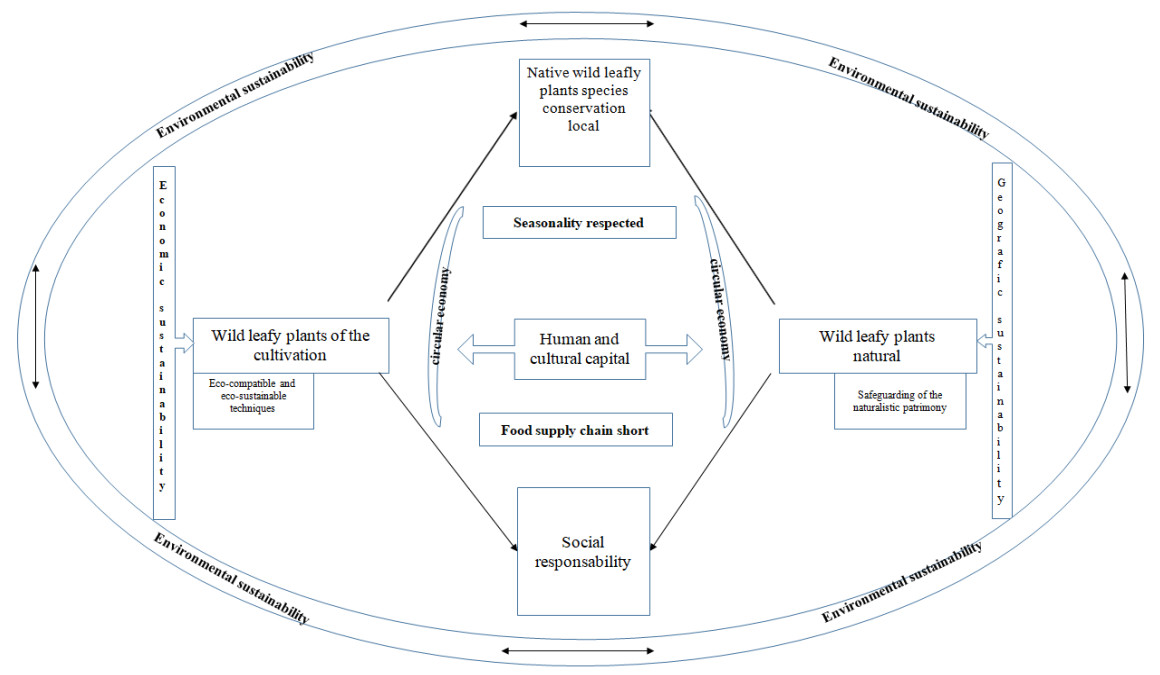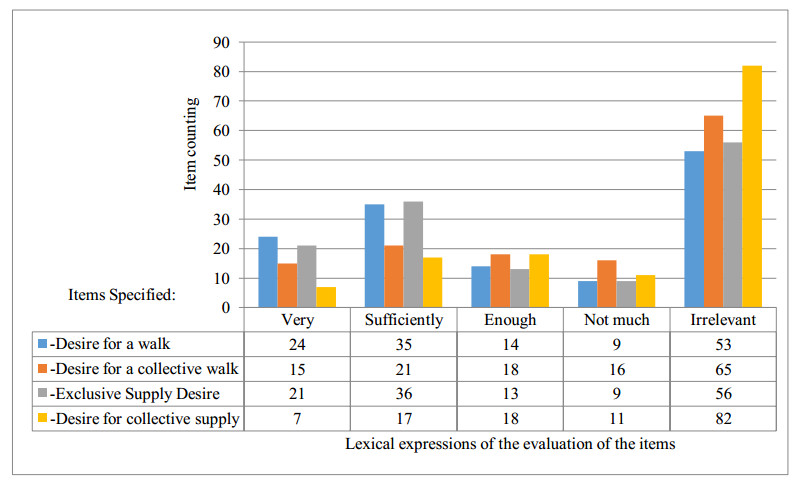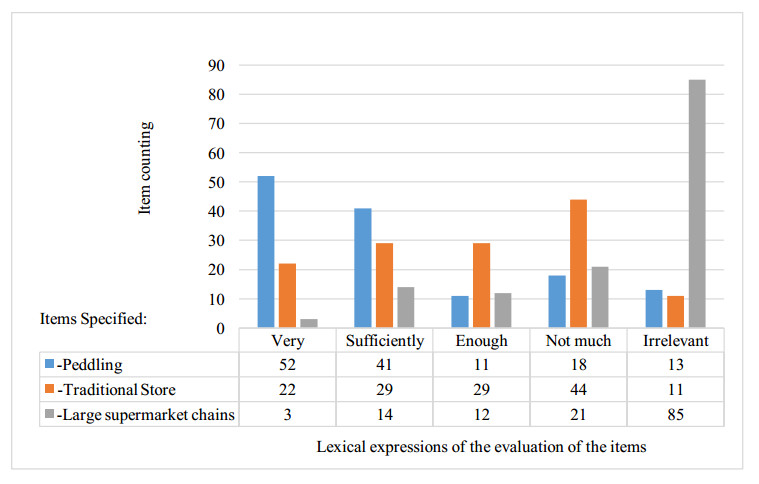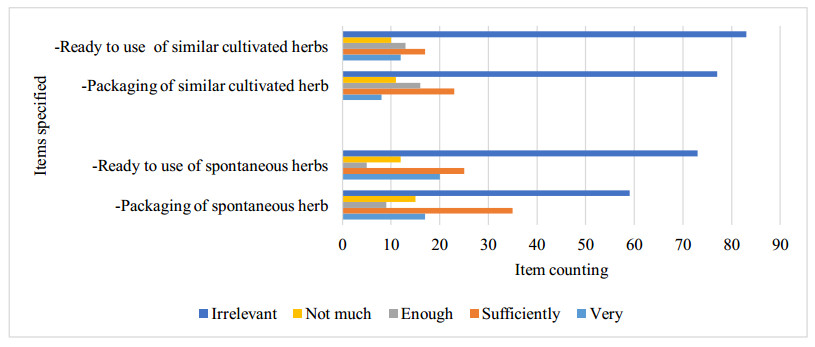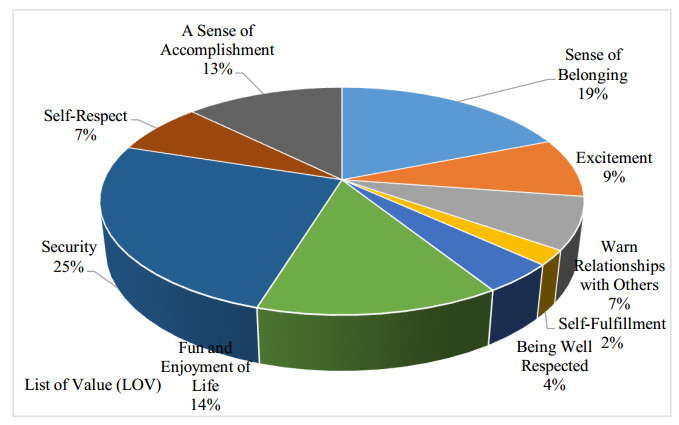This study aimed to evaluate potential changes in habitual and occasional consumers in the use of wild plants in human nutrition. This objective was achieved towards research carried out in a territory rich on biodiversity and agricultural landscapes (wild plants strip), place of origin of many civilizations; that is, in Sicily. The results of a sample of 134 people—supported by discussions with local peddlers—have shown that the interest for human consumption of wild leafy ‘vegetables’ is widespread, so much so that these are included among new food lifestyles. Mainly nutritional aspects related to health, popular tradition and the sustainable perspective determine the value of these vegetables. The importance of preserving and enhancing the local edible flora emerges, if the relative market conditions (season nature of wild leafy plants; food supply chain) are in close synergy with the principles of the circular economy.
1.
Introduction
Wild plants have always been widely used in the field of human nutrition and today there is a growing need for healthy foods that draw on popular knowledge where spontaneous 'vegetables' play an important role, although many observers claim that their knowledge and consumption is decreasing worldwide [1]; the cause is due to modernization and new lifestyles 1[2]. Wild food, in prehistoric times, was a key source of food for humans, but it has since declined with agricultural expansion and later with the Industrial Revolution [1].
1 Modernization involves the hasty consumption of food outside the home, so much so that it does not allow, at least in the daily routine, to consume a well-maintained food. In the world, lifestyles emerge that take into account rational, emotional and psychological elements in the decision-making process. Food is the emblematic representation of mental categories reflected in it, or it is a multifunctional means capable of providing benefits and values by satisfying physical and mental needs.
Contemporary urban diets have reduced the presence of wild plants, favoring some species leaving other edible species unaffected by the process of evolution [3].
Wild vegetables are fully natural and territorial assets among those handed down from generation to generation, especially in areas where a rural reality economic and social is actual and active. In rural areas, the practice of collecting wild plants goes beyond the primary need for consumption, it, in fact, represents the pleasure of the activity itself, or rather to relate with the natural environment.
According to Menéndez-Baceta [1], the 'amenity of the countryside' is combined with other peculiarities, that is: Ⅰ) continue to contribute to food security and sovereignty, especially in non-industrialized countries; Ⅱ) largely contribute to subsistence economies; Ⅲ) hold potential to reactivate rural economies; and Ⅳ) help maintain local identities, with likely effects on biodiversity conservation.
Some observers (Zhang, 2007) support all the elements defined as prerogatives of tradition; still wild herbs as a food resource are becoming increasingly more important to consumers with modern lifestyles [4]. Metropolitan consumers are enjoying a return to nature and welcoming the health benefits provided by edible wild vegetables.
Sociocultural factors, such as local appreciation of taste or the search for natural and healthy foods, seem to increase the popularity of wild plants [5]. Corrado Barberis has demonstrated, from studies carried out in Italy that the maintenance of local traditional food specialties reflects lifestyles entrusted with the defence of local culture. Furthermore, the consumption of these wild 'vegetables' influences the sensitivity of the local population because some species have nutraceutical [6] and therapeutic capacity [7] and/or their ability to influence the conservation and enhancement of the local indigenous biodiversity and the environment.
2.
Materials and methods
2.1. Area of investigation: Sicily
In the central-eastern territory of the island 'Inland Hills' and 'Hyblaean plateau', the investigation took place, encompassing mainly the provinces of Ragusa, Enna and, in relatively small territorial dimensions, the province of Catania in the parcel that connects the two provinces, as well as the neighbouring province of Syracuse.
In the area, there are many watercourses and basins, the natural one of Pergusa and other artificial ones (the main ones being Pozzillo, Nicoletti, Ancipa, Ogliastro, Dirillo and Santa Rosalia). The most important waterways are the Simeto, the Salso, the Ippari, the Dirillo and the Irminio. Rather interesting as examples of environmental protection are nature reserves, such as the 'Macchia', 'Pino D'Aleppo', 'Pantani' of south-eastern Sicily, the 'Woods of Rossomanno-Grottascura-Bellia', 'Monte Altesina', 'Vallone del Piano della Corte' and the 'Forre Laviche del Simeto'. An important site is the sulphur mines park of Floristella-Grottacalda, which in the past determined the economic development of the local area. The territory is scattered with small municipalities where the main administrative, financial, healthcare and education facilities are located.
The landscape is predominantly hilly (61.4%) with a mountainous area (24.5%); the remainder being a coastal area with a strong agricultural, fishing and tourism focus.
In the investigated area [8] the total population exceeds just over 500,000 inhabitants, with a density of about 85 inhabitants per square kilometer. The time period of reference is the one following the exodus of migration in the 50s and 70s, there is a slight increase in population, however, in recent years the population has stabilized due to new migration and aging, a phenomenon common to the entire Sicilian territory. The average life expectancy in this area is 74.4 years for men and 78.8 years for women. The taxable per capita income varies widely, from 10,000 euro to 26,000 euro (record in 2007). The area examined have by the strong productive vitality of the agricultural sector, which puts it in a position of absolute supremacy throughout Sicily within the productive sectors. From this point of view, the production of cereals, citrus fruits, olives, table and wine grapes, various fruits, etc. is considerable; the livestock and fishing sectors are equally prosperous. The horticultural cultivation in the conservation areas is significant. The formation of GDP is also due to the transformation of agri-food products (mills, dairies, pasta factories). The presence of accommodation facilities and gastronomic activities is important, above all because is the growing tourism, attracted by the natural, historical and cultural aspects that characterize the territory.
These traditional products derived from the great agricultural and gastronomic heritage of the Sicilian territory are threatened by the risk of extinction or by the loss of those characteristic requirements which guarantee their quality standard.
In the territory, there are numerous wild species of human nutrition. Table 1 lists the main species of wild leafy plants that we are investigating.
Other typical examples [9] are the wild artichoke with small spiny heads (Cynara cardunculus), the rocket (Diplotaxis tenuifolia), the wild radish (Raphanus raphanister), the wild spring onion (Muscari comosum) [10]; other minor species typical of traditional and healthy are of little relevance for to recurrent food consumption [11].
This is one of the reasons why in Sicily, especially in large urban centers, peddling is to this day an enduring business—particularly if the peddler is a well-known collector—with an itinerant market stall or selling from a semifixed location.
2.2. Data analysis
For the identification of the geographical areas, we availed ourselves of researches previously carried out in Sicily and the contribution of professional (ethnobotanical) experts in autochthonous biodiversity [12,13].
Among the geographical areas identified, we selected those marked by municipalities having a different population for consistency, presenting heterogeneous conditions from an economic and social point of view, and highlighting their agro-food lifestyles for natural products.
Specifically, n. 134 consumers represent the sample, of which n. 95 for the Inland Sicilian Hills (i.e., the local contexts of Caltanissetta, Enna, and, partially, Catania); while n. 39 represents the sample of inhabitants of Hyblaean Plateau (including the provinces of Syracuse and Ragusa).
The interviews were carried out with the help of a specially designed multiple-choice survey (Questionnaire in Appendix) formulated to place at the center of the consumer's interest a set of important variables, which alter the purchasing decision-making process on three perspectives: cognitive, behavioristic and experiential [2]. These three perspectives were obtained from a study of the consumer's purchasing attitude, each consisting of a collection of 9 statements (items), which were deemed sufficient, so as to avoid encumbering the interview and to measure attitudes at different levels of evaluation with the traditional method of the Likert scale. The Likert scale is a unipolar scale of questions composed of five modes of response with partial semantic autonomy (Very, Sufficiently, Enough, Not much, Irrelevant). In order to ascertain the intensity of each of these statistical mutability, the latter are transformed into statistical variables, i.e., marked with whole scores (equidistant ratio of natural numbers 1 to 5); making it possible to evaluate (position) the people, for each item investigated, through the determination of the average of the relative scores expressed.
The possibility of linking the spontaneous vegetables to certain terminal values—structured between internal and external values to represent also interpersonal relationships—can give indications on the availability for consumption of these products. The questionnaire closes the interview with nine questions based on the List of Values (the LOV scale) with answers to former evaluations, consistent with the Likert method [14].
Therefore, the survey aims at the relationships that the interviewed people claim to have with the topic under consideration, depending on the experiences they have. In particular, it is a question of examining the relationships between dependent variables and independent variables, suitably developed through the bivariate tabular analysis. The quantification of the relationships that indicate the trends was transform into graphic representations to facilitate the immediate perception of the phenomenon observed and the comparison between different phenomena. This is an empirical research based on the phenomenographic method useful for a concrete vision of learning about behaviors, values and preferences on the subject under investigation.
Integrated study, the survey of wild plant itinerant local peddlers [15]. Most of these commercial figures belong to rural community families with a strong popular knowledge of leafy wild plants for culinary use [16]. This commercial activity, generally, has occasional character frequently in conjunction with seasonal production.
The aim the interview to the itinerant-gatherers was to acquire information on the places of origin of the wild leafy plants sold, on the origin of the usual consumer and on the frequency of non-local purchasers.
For this commercial form, statistically included among typical phenomena has made it possible to exclude the sample hypothesis. In fact, it was sufficient to concentrate the interviews on a few cases (based on the commercial location of the peddlers) to realize the knowledge of the phenomenon; considering that the peddlers of the area under investigation did not present any differences with those interviewed.
It was important in the interviews to verify the sensitivity of the consumer of 'wild vegetables' in relation to non-seasonal purchases, also evaluating the propensity to purchase the packaged product, in particular if the vegetables are ready for consumption [17].
In our area of investigation, there are many farmers with a keen interest in the cultivation of species still considered spontaneous. In this sense, the local actions of companies directly committed to the production of spontaneous plants can be a step towards their preservation and the transmission of popular knowledge.
Particular attention was indeed paid in the interviews with street vendors to the protection and preservation of local spontaneous biodiversity and, more generally, of its environmental sustainability [18,19]. This is for an integration of the knowledge on the socio-economic reality of the territory and on the responsibilities of all the figures who contribute to the functioning of the local system in respect of the environment (circular economy) (Figure 1).
From these two directions of investigation (people and peddlers), it is argue that most of the variables useful to identify segments of consumer behavior and decision to purchase wild leafy plants is satisfactory. In fact, given the complexity of the phenomenon and the lack of a single criterion to guide and interpret the cognitive segmentation of the consumer, which is not only statistical, was obvious.
However, it was not possible in the study to assess whether price is the variable used to discriminate between demand and product. This is because it is not currently possible to examine the rules of segmentation of a tangible market.
3.
Results
Useful indications report the results of the interviews on consumer behavior in the choice of wild leafy plants in human nutrition.
The first indication emerged is important: that is, to what extent other elements, compared to the food benefit, can influence the consumption of wild leaf plants. The results described 'irrelevant' (Figure 2).
However, certain non-food benefits can induce the consumption of spontaneous plants; Figure 3 shows some elements that influence the need and decision to purchase. In particular, 'Historical memory of the family', 'Diet' and 'Symbolic experience' are the main elements influencing consumer behavior. Elements that in some way refer to tradition and health care direct the cognitive sphere of most consumers. 'Cultural education' and even more the element 'External dissuasion effect' are less significant in influencing demand.
With regard to place of purchase, in Figure 4 here it is evident that purchases at the stalls of street vendors prevail, followed immediately by traditional points of sale, while purchases in supermarket chains are of little relevance.
The frequency of purchases is almost customary for people who live near the store, and occasional or rare for non-local buyers.
With regard to the modality in which the product is purchased, purchases of the product bulk prevail (i.e., a set of plant leafy species); this modality a way that directs consumer demand on peddlers. This is also due to the possibility given to the consumer to vary the quantities of supplies with mixed species; indeed, the purchase of individual species it is not usual. Figure 5 shows, in fact, the low interest of consumers in packaged purchases; this condition is also valid for 'similar cultivated herb'.
Table 2 shows the socio-demographic factors of the sample that most influence the decision-making process in the use of wild vegetables. In particular, age is a determining factor, especially in the 51-65 age groups and above; the level of education is the high school diploma; the level of income and profession (especially as head of household) seems to have little influence on the decision-making process.
With reference the capacity of the spontaneous vegetables to provide benefits conforming to expectations (in mind the cognitive, behavioral and experiential) consumer approach, the orientation is mainly subjective. In essence, the individual selects, interprets and organizes the choice of spontaneous vegetables as part of a hierarchical process of existential: 'List of values' (LOV scale). The existential condition as a terminal value most attributed to the spontaneous vegetables is 'safety', immediately followed by 'sense of belonging' (Figure 6). Other important values that express the strictly individual condition, relate to the 'fulfillment', 'excitement', 'self-realization' and 'self-respect'. The interpersonal sphere, consumers give importance to the main external terminal values 'Fun and pleasure to live' and 'friendly relationships with other people'.
Interesting were the interviews with street vendors aimed at acquiring further information on consumer behaviour. The peddlers are the guarantors of the local origin of the wild vegetables. The 'location' factor is the primary element of the purchasing decision; the short distance from the place of harvest to the point of sale guarantees the 'freshness' of the product and the lower environmental impact ('miles of food'). A set of elements that for some categories of consumers (women and men from rural families), make unfulfilled desire more bearable the need to collect wild vegetables directly.
The urban purchaser in principle shows interest to wild plants, as they endowed with nutraceutical qualities and phyto-therapeutic; this knowledge makes this buying behaviour prevail between women and older people. In general, therefore, we find a sensitivity to environmental sustainability from the part of the users of edible wild plants. These vegetables make it possible to combine the eco-sustainable condition of the natural environment to the maintenance of the food and health characteristics of the wild leafy 'vegetables'. A healthy identification that the consumer deems most significant when the consumption coincides with the 'seasonality' of the each species vegetables. Moreover, the purchaser is aware that seasonality gives an environmental advantage to the quality of the food and the well-being enjoyed.
4.
Discussions
This study has shown that local herbs for human nutrition, represent a forms of consumption to integrate to varying degrees the demand for food products of plant origin (experiential and ethical consumption) and a local economic potential (income support schemes).
From this study it emerged that the market availability of 'wild vegetables' currently derives both from direct harvesting from the fields and from the availability of quantities resulting from cultivation in the current agronomic techniques. At first glance, the two things seem to be one in to the opposed of the other. Instead, the study has shown extracting new horticultural forms from some of the traditional vegetable species of human nutrition to improve the current ones can be of great benefit to all.
This virtuous synergy, supply/demand characterizes a new small but potentially growing market. Let it be clear, however, that consumers are more willing to buy the wild leafy vegetables of their environment; in other words, of their land, indicated and defined by the language of its tradition.
Indeed, the importance of a commercial site goes far beyond the consideration that spontaneous vegetables play an economic role, because it intersects at the same time the fundamental relationship between consumers and their environment.
The behavior of the consumer (explicit need) is the result of a set of variables, which act at different levels of awareness of people, according to an order of priority and relevance that vary. Specifically, emerge subjective distinctions such as gastronomic gratification - connected to a sense of belonging to one's native land, strengthened by relational distinctions - at the same time, the importance of the family's historical memory, capable of preserving and reinforcing the symbolic dimension ascribed to spontaneous edible vegetables.
The decision of the consumer at the time of the purchase (requirement of usefulness) is directed to linear signals that prove the origin of the spontaneous 'vegetables' and the characteristics of the commercial figure to which the overcoming of the informative asymmetry points. That is, a reassurance of virtuous integration between spontaneous 'local' and 'seasonal' flora as a prerequisite for the best conditions of equilibrium between supply and demand.
This is economic-environmental situations favorable to the reduction of logistics and transport costs, which prevents food waste (circular economy).
The results achieved so appear to be responsive to new trends in which edible wild vegetables are not foreign to the currently existing food culture.
From the cultural identity of the people, the wild food 'vegetables' become a substantial expression of sustainable development and social cohesion. The awareness of being able to define the length of the supply chain and the food quality are a privileged contribution to maintain or increase the sustainability of local agri-food systems.
The human consumption of wild leafy plants, in relation to the change of lifestyles and the growing demand for natural vegetables for nutraceuticals, on the one hand, tends to make these natural goods sustainable and on the other, it stimulates the spreading of the cultural and historical heritage.
5.
Conclusions
Our survey shows that in recent years the consumption of spontaneous 'vegetables' has increased, in opposition to global trends.
In this recurrent dichotomy, our study suggests a possible affirmation; the demand takes on different connotations when wild plants recall very specific places. Therefore, the key component for the analysis of such change is a constant evolutionary process in the time and space of accumulation and re-elaboration of traditions.
The determiner of decision-making process (expressed need) are the nature of the consumer together with the environment condition (market).
In conclusion, the message of this work consists in giving new incentives for new research. That is, with reference to other social microenvironments and / or social macro-environments use the results of the study to set up other tests on food sustainability and on the corresponding enhancement of leafed wild plants. In fact, using a similar path is possible if you take into account the binomial 'need-profit' as long as it is not detached protection of local environmental values. The need refers to the functional and psychosocial point of view of the consumer; the profit instead pursues the objective of strengthening the commercial position of the seller and farms that produce wild leafy plants.The protection of local environmental values refers the conservation and enhancement of the local territory while respecting biodiversity. These are elements of absolute importance in which the figures called must act with the perspective of conservation and enhancement of native plant species. In light of this situation, we believe it possible that the realization of a local system that takes highly into account the consequences of the surrounding environment, both natural and social can be supported by a strong the identity and sense responsibility of local communities.
In this connotation, a virtuous local system take life, which is able to give unequivocal answers to the new European agricultural policy on sustainable growth (circular economy) and food security, avoiding dangerous and uncontrolled upheavals for citizens and for a new institutional market.
In conclusion, in a local system with the values highlighted, the key to success is that the elements of tradition become factors of development and that the elements of local biodiversity translate into economy and vice versa.
Acknowledgements
Financial support from the Department Agriculture, Food and Environment (Di3A), University of Catania, Italy.
Conflict of interest
All authors declare no conflicts of interest in this paper.









 DownLoad:
DownLoad:








